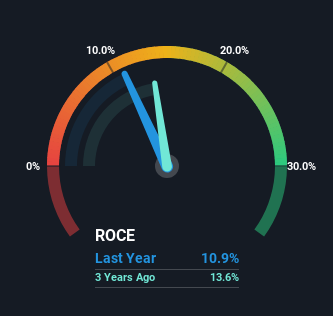Return Trends At Albany International (NYSE:AIN) Aren't Appealing
Finding a business that has the potential to grow substantially is not easy, but it is possible if we look at a few key financial metrics. Firstly, we'd want to identify a growing return on capital employed (ROCE) and then alongside that, an ever-increasing base of capital employed. Basically this means that a company has profitable initiatives that it can continue to reinvest in, which is a trait of a compounding machine. That's why when we briefly looked at Albany International's (NYSE:AIN) ROCE trend, we were pretty happy with what we saw.
Understanding Return On Capital Employed (ROCE)
For those that aren't sure what ROCE is, it measures the amount of pre-tax profits a company can generate from the capital employed in its business. The formula for this calculation on Albany International is:
Return on Capital Employed = Earnings Before Interest and Tax (EBIT) ÷ (Total Assets - Current Liabilities)
0.11 = US$168m ÷ (US$1.8b - US$243m) (Based on the trailing twelve months to September 2023).
Thus, Albany International has an ROCE of 11%. That's a relatively normal return on capital, and it's around the 12% generated by the Machinery industry.
See our latest analysis for Albany International
Above you can see how the current ROCE for Albany International compares to its prior returns on capital, but there's only so much you can tell from the past. If you'd like to see what analysts are forecasting going forward, you should check out our free report for Albany International.
How Are Returns Trending?
While the current returns on capital are decent, they haven't changed much. Over the past five years, ROCE has remained relatively flat at around 11% and the business has deployed 25% more capital into its operations. 11% is a pretty standard return, and it provides some comfort knowing that Albany International has consistently earned this amount. Over long periods of time, returns like these might not be too exciting, but with consistency they can pay off in terms of share price returns.
The Key Takeaway
To sum it up, Albany International has simply been reinvesting capital steadily, at those decent rates of return. In light of this, the stock has only gained 35% over the last five years for shareholders who have owned the stock in this period. So to determine if Albany International is a multi-bagger going forward, we'd suggest digging deeper into the company's other fundamentals.
If you're still interested in Albany International it's worth checking out our FREE intrinsic value approximation to see if it's trading at an attractive price in other respects.
While Albany International isn't earning the highest return, check out this free list of companies that are earning high returns on equity with solid balance sheets.
Have feedback on this article? Concerned about the content? Get in touch with us directly. Alternatively, email editorial-team (at) simplywallst.com.
This article by Simply Wall St is general in nature. We provide commentary based on historical data and analyst forecasts only using an unbiased methodology and our articles are not intended to be financial advice. It does not constitute a recommendation to buy or sell any stock, and does not take account of your objectives, or your financial situation. We aim to bring you long-term focused analysis driven by fundamental data. Note that our analysis may not factor in the latest price-sensitive company announcements or qualitative material. Simply Wall St has no position in any stocks mentioned.

